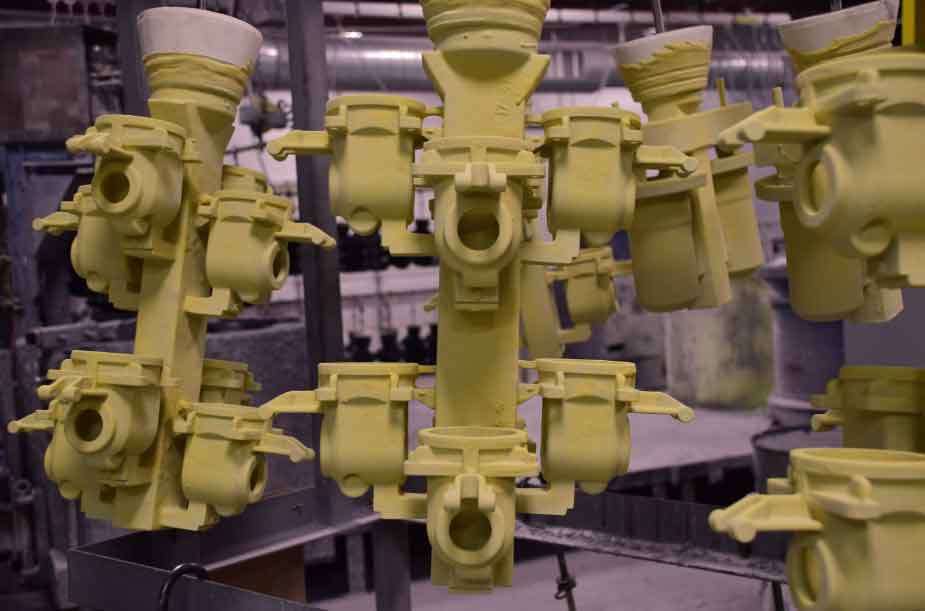Investment casting, also known as lost-wax casting, is a versatile and complex manufacturing process used to create intricate metal components with high precision. It offers several advantages over other casting methods, making it a popular choice in various industries, including aerospace, automotive, and jewelry manufacturing. In this response, we will explore the versatility of investment casting by discussing its precision and complexity.

Precision in Investment Casting:
Investment casting is renowned for its ability to produce parts with exceptional precision and dimensional accuracy. The process begins with the creation of a wax pattern that replicates the desired part. This pattern is typically produced using injection molding or built by hand. The pattern is then attached to a gating system, creating a cluster of patterns that will be invested.
The next step involves creating a ceramic shell around the wax patterns. The ceramic shell is formed by dipping the pattern cluster into a series of ceramic slurries and then coating it with fine ceramic particles (stucco). This process is repeated multiple times to achieve the desired shell thickness.
Once the ceramic shell has dried and hardened, it undergoes a high-temperature burnout process to remove the wax from inside the shell, leaving behind a hollow cavity in the shape of the desired part. This cavity is then filled with molten metal, usually through gravity pouring or vacuum casting.
The molten metal solidifies inside the ceramic shell, taking the shape of the cavity and forming the final part. After cooling and solidification, the ceramic shell is broken away, revealing the cast metal part. The resulting components exhibit excellent dimensional accuracy, fine surface finish, and intricate detail reproduction.
Complexity in Investment Casting:
Investment casting enables the production of highly complex and intricate parts that would be difficult or impossible to manufacture using other techniques. The process allows for the casting of thin-walled sections, undercuts, internal cavities, and complex geometries with sharp corners and fine details.
Investment casting can accommodate a wide range of materials, including ferrous and non-ferrous alloys, such as stainless steel, aluminum, titanium, and superalloys. This versatility in material selection further expands the range of applications for investment cast components.
Moreover, investment casting offers flexibility in design modifications. Since the wax pattern is used to create the ceramic mold, it is relatively easy to modify or create different patterns, allowing for design iterations and rapid prototyping. This flexibility is particularly beneficial in industries where design optimization and customization are critical.
Applications of Investment Casting:
The precision and complexity achievable through investment casting make it suitable for various applications. Some common industries where investment casting finds extensive use include:
- Aerospace: Investment casting is utilized to manufacture turbine blades, vanes, engine components, and structural parts in the aerospace industry. The complex geometries and heat-resistant properties of superalloys used in investment casting make it ideal for aerospace applications.
- Automotive: Investment casting is employed to produce components for engines, transmission systems, braking systems, and chassis parts in the automotive sector. The lightweight and high-strength properties of investment cast components contribute to improved fuel efficiency and overall performance.
- Medical: Investment casting is utilized in the medical field to manufacture orthopedic implants, surgical instruments, and dental components. The ability to create intricate and customized designs makes investment casting valuable in this industry.
- Jewelry: Investment casting is widely used in the jewelry industry to create intricate and finely detailed designs. The process allows for the production of complex shapes and delicate patterns that are difficult to achieve through other manufacturing methods.
In conclusion, investment casting is a highly versatile manufacturing process known for its precision and complexity. It enables the production of intricate parts with high dimensional accuracy and excellent surface finish. The ability to cast complex geometries and accommodate a wide range of materials makes investment casting suitable for various industries, including aerospace, automotive, medical,
